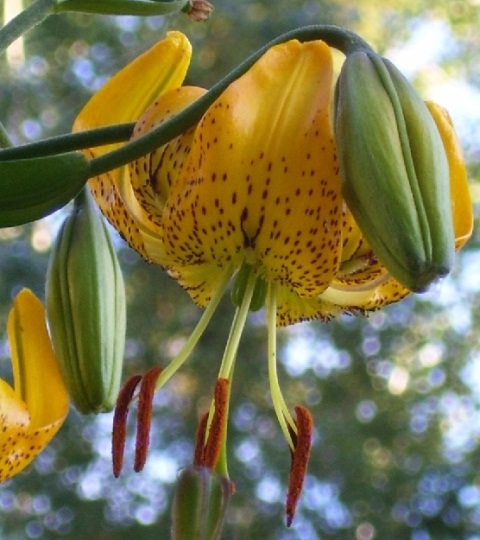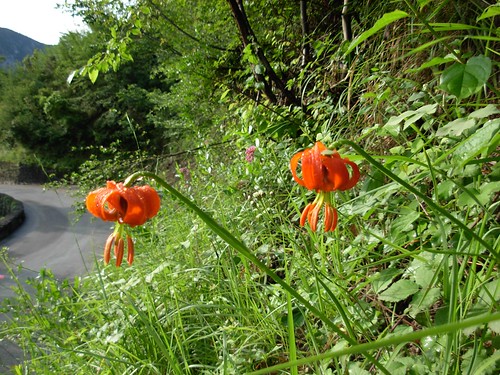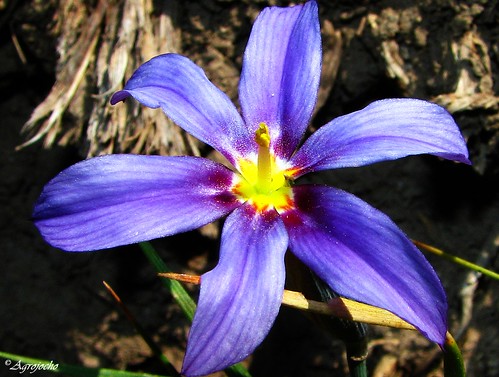Hello, welcome to my 100th post. I thought we could celebrate by me rambling on about what's going on in pots on my roof – probably much the same as is happening in your garden, but with more greenfly. Is it just me or is it a bumper year for the little suckers? But first, some pics of my Fritillaria pallidiflora.
t |
| It's an international bulbous bonanza – Iris bucharica from Afghanistan, Tadjikistan and Uzbekistan and, above, Fritillaria pallidiflora from China and Siberia. so, yes, they're both very hardy |
 |
| Nice, eh? I won't patronise you but note the lack of tessellation. There are a few brown flecks on the inside of the bells but they're frankly not worth showing you. My plant is about a foot tall and I'm very happy with my three pallid flowers. |
And just to clear up the Fritillaria acmopetala confusion once and for all, it has finally bloomed, leaving persica as the only Frit to bloom although it's halfway there with a topping of chocolate bells that should reach perfection in a day or two (it's hard to tell in this weather). I've already watered extensively, like, with the hose, and you wouldn't know it. And I know you have to soak each pot or you're doing more harm than good by enouraging the roots to head upwards because that's where the water is. Remeber that, any sprinklers out there – and you water the soil, not the leaves.
 |
| Not much going on in the inside either but there you have it, thank god for the wendelboi variety which has much more pronounced markings |
Anyway.
Don't you just love pricking out anonymous seedlings, hoping like hell that they're something cool and then remembering that you wouldn't have ordered anything but the weirdest, rarest, least suitable for London rooftop seeds. I would be apoplectic at the ghostly fading of the indelible marker pen that means I have dozens of pots with no indication as to what is in them other than the seed leaves and then, fortunately, the true leaves. This has worked to an extent; I have identified one as a primula and another as an Iris. And by a process of elimination I think it must be Iris laevigata. I don't want Iris laevigata, I have a finite amount of space and non-descript members of my favourite genus are not welcome. But I did by the seed, almost as if feeding some sort of addiction.
 |
| Definitely Primulas, and I'm pretty sure some Delphiniums. But what the hell is that bottom right? |
 |
| Lilium amabile (let's just call it "yellow form" while the taxonomists argue about pairs of chromosomes and dead languages, one of which I speak, to O-grade level. Guess what? "garden" is "horto" in Latin. You'd have to be dead not to work that out. |
However, much excitement at seedlings that do have labels, particularly Lilium Amabile (controversial yellow form that has never been officially named - it's usually deep orange/red), Lilium regale (I've never seen the appeal, I think partly because it always looks like it's about to fall over, and Lilium pomponium, which I was good enough to show show in the previous post but if you can't be bothered, it's a short little thing with a huge amount of leaves and one perfect red flower atop them. I'll take six please. Actually I've only got three up so far but these things tend to happen in a flash so I'm expecting more over the next few days. I could show you photos but you know what lily, and actually most monocot, seedlings look like now:like a lover case "n" that straightens out, one end having been the root, which gets to explore compost, the other the shoot tip, which gets to see the shitty old world and pray for stem rot.
But here are the flowers because they're pretty:
 |
| A great shot by "Gunera" of amabile growing by the road somewhere in Europe, most likely France. I want to know what the pink thing in the background is now! |
 |
| The instantly recognisable but often impersonated (sargentiae, wallachianum, are you listening). I don't know why I wouldn't grow it in my toilet, it's a beautiful plant but you've probably noticed I like my plants a bit scrappier! |
Regardless, seed is now my favourite manner of propagation, mainly because I don't have ready access to the perennials and shrubs of the Himalayas to strike cuttings from. And you can't take cuttings from monocot plants anyway (that's anything that looks a bit like grass: almost all bulbs/corms, rhizomes and tubers, although there are dicot (generally pairs of leaves such as Roses, Rhododendrons and Runner Beans (see the lengths to which I am forced to travel to complete a Ciceronian triplet and thus keep my copy flowing like water over pebbles in a babblig brook, overhung by ancient Beech trees and with a resident Kingfisher shaking the water off his back before tilting his head back and swallowing his tiny catch in one).
Plenty of the seeds from chileflora.com have germinated with no help from artificial heat, as have more Gladioli. These is a theory that this is down to extremes of temperature in the same 24 hours, something that the spinning of the earth on its axis takes care of for us. You know about the three species of Rhodophiala: bifida, splendens and montana. I also showed you a stunning magenta Oxalis. Well this week something called Solenomelus segethii zoomed up – and when you see it you'll see exactly what drew me to it!
 |
| Yeah, it does have a certain Iris-like quality, doesn't it? |
The Clematis tower has been draped with the gorgeous Jacqelin du Pré and it's mates, given a good chopping back a month or so ago (container grown Clematis have a far more rigorous pruning regime than those in the ground. Unless they're about to flower, they're cut to about a foot in Feb/March)
 |
| And sunshine too! |
It has been a mixed week: The Lilies are almost all through, some of the species such as hansonii and latifolium, and the white martagons which I somehow managed to have three pots of (and seeds!) while forgetting to buy the type and it's sexy dark red, almost burgundy form (now rectified) can almost be heard growing, the big, chunky hunks. I've also snapped up what was advertised as martagon "yellow bunting" and this is growing nicely, three bulbs having a huge pot to themselves but this seems to be offered as a variety of pumilum by everyone else and it lacks the flecking on the petals that are such a feature of the martagons. But one thing is clear: I have too many lilies crammed into too many small pots. This will be fine this year (although toppling is going to be an issue) but I don't want to go repotting after just one year, I'd rather get them established first.
Many, bought from extremely reputable suppliers, have been a bit of a disappointment, sending up just a few single leaves or short, blind, shoots that won't flower, despite them being sold as being of flowering size and looking pretty chunky when I planted them. Plants such as L. ducharteri, in 2litre pots, have just sent up half a dozen stems with three or four small leaves, which is very disappointing. But at least there's something in there. I'm concerned about about my two pots of L. Nepalense, which are showing no signs of life. I also took a gamble on eBay and bought a few bulbs from a guy in China. The first, L. amoenum, arrived rotten and the others, apart from L. Poilanei (so sexy it's worth taking a risk on!), were described simply as Lilies from Szechuan. They arrived looking well but there's no sign of growth yet and I know there's still time but it's a bit of a coincidence that none of his Lilies (nor his Nomocharis aperta) have shown themselves.
Also, nothing from my two pots, from different sources, of L. Nepalense although a tiny leaf has today poppped up in Oxypetalum v. insigne. Canadense remains somewhere east of Newfoundland and superbum is biding its time too.
Still, lots of little flowers to show you:
 |
| Rhododendron "Wee Bee" |
 |
| Rhododendron "Little Ben" |
 |
| Dodecatheon hendersonii, 3-4inch stem emerging from a perfect rosette. It opens slightly further in a Cyclamen stylee. It really is a gem, get one now for a shady but of the rockery! |
And now a couple more to keep it company, which will enjoy the same semi-shade and that ubiquitous moist but well-drained soil. I can only assume it means plenty of humus (the soil, not the chick pea thing) and perhaps a bit of grit, especially for the gob-smacking Pulsatilla I'm about to show you. In a bit.
 |
| Anemone x lipsiense, a woodlander, so plenty of leafmould or rotted bark and a spot where it won't get the mid-day sun or too much of it at any other time of the day. It spreads underground, I'm not sure by what means because I don't want to tip it out of the pot but stolons of some kind. Probably. |
In the same delivery I also got an Allium flavum but it would be like showing you a spring onion with the bottom chopped off. I hope mine's orange, they come in the same range as Lewisias but paler. If it's pink I'll be annoyed. I had a pot of seed but it was well and truly squirrelled so, while I've left it as I found it, I'm unlikely to get much luck and I'm not sure the roof can handle many more bulb seedlings, what with 40 or so Gladioli, a number of Moraeas, and, just lately, Irises and Lilies. Fortunately I get to leaves the Glads in their 7cm square pots for a year. There are so few seeds (never more than 10 to a pot) and success varies from 100% to 10 – I only want one anyway) they don't get crowded and have a chance to build up a bulb, sorry, corm, before they are distrurbed.
Anyway, that other Alpine ...
 |
Pulsatilla alpina sulphurea: demure, diminutive and delicious (in a visual way. I wouldn't recommend eating it).
|
I'm slightly overwhelmed with rare and choice bloomery so let's just have a look at them, yeah, starting with a plant that wouldn't have been possible 20 years ago when Meconopsis punicea, an extemely delicate red thing thought extinct but fortunately it wasn't and neither was Meconopsis quintuplinervia, a rather drab (if the genus could ever have a member so described).
Actually, it's not that drab, it was just never going to win against betonicifola. Now, these plants are delicate, apt to live short if exciting lives and have a chromosone thing going on. So some bright spark by the name of Cook got his/her paint brush out and came up with a not purple but a lovely coral pink hybrid with all the best bits of both. Usually in hybridisation you'll end up with a stunningly coloured bloom on a stem that can't support it or a fabulous scent from a grey flower. So when these two fell in love and produced the following, we all got a bit excited.

 |
| Papery perfection: these are both the same bloom, even though the lower looks slightly bluer. I don't know why, time out of the spikey bud I suppose. And guess what the best thing about this is? Unlike its parents, it doesn't die after flowering! You can keep punicea and quintuplinervia gonig for a year or two but if you grow them I suggest collecting and sowing seed annually. Fresh seed will germinate more readily but you can store it in a paper envelope in a dry place for a year or more but the longer you leave it the more sporadic or non-existent the germination. |
Recent deliveries include the 10 species Pelargoniums (which we'll go into detail next time) I ordered last year, five named Auriculas and, today, a Lily order I have no recollection of ordering but I must have. I would have been a long time ago because the last thing I need is another Lilium leichtlinii! also in there were superbum, davidii, suberbum, pumilum (I think I have double figures of this now). It was a joy to receive another lophophorum because my current specimen has yet to show signs of life and "Fata Morgana" is a bizarre thing worth having. Also, the picture of davidii on their website is a lovely shade, rather than the typical bright orange. Whether mine will be this shade, time will tell, but I hope it is:
And to round off, the first bearded Irises of the season (the stem of one broke within hours of me realising what it contained).
 |
| Iris "Extra" |
 |
Iris "Hocus Pocus"
|
And that's all for now, I have an appointment with a hose. Sigh. Brits, enjoy the weather, everyone else, you probably see the sun most days but enjoy it anyway and everyone, enjoy your plants!
The Plantboy





























No comments:
Post a Comment